CHAPTER 4
Independent Telephone Company
Mobile Telephones
While these pages are a study of the mobile telephone in Bell System service, the independent telephone companies also offered them, using equipment of their own design, sharing the same channels and often the same formats, and thus are worthy of mention.
These independent telephone companies, i.e. those not affiliated with the Bell System, offered mobile subscriber equipment not always the same as that used by the Bell affiliates, but which operated on the same channels and was generally compatible with Bell systems should the subscriber travel to a "foreign area" while "roaming." The independents should not be confused with RCC's, or Radio Common Carriers, which were privately owned firms, usually paging and answering service companies, operating on a different set of channels incompatible with Bell System equipment.. The independent telephone companies in the 1970's with mobile systems were mainly Continental Telephone and GTE, but there were dozens of others including many rural telephone "co-ops."
Information on the first independent telephone company mobile telephone system is very hard to come by. At least by 1949, the independents had systems quite similar to Bell and Western Electric equipment. Two of the most recognized independent telephone companies were Continental Telephone (Con-Tel) and GTE. GTE was the largest independent telephone company in the USA. GTE acquired Con-Tel in 1991, and owned the Automatic Electric Co., which was to GTE what Western Electric was to the Bell System. GTE also acquired Lenkurt Corp. and consolidated Automatic Electric and Lenkurt in 1960. Lenkurt and Automatic Electric were the manufacturing arms of GTE.
Prior to the introduction of IMTS by the manufacturers, these independent companies sought ways to cut costs of paying operator staff to handle mobile calls. The Dial, Identified Dial, and Pushbutton Dial systems were a way to do this, by eliminating the need for a mobile operator to dial the calls. Even after the availability of IMTS equipment, some Bell System operating companies continued to use Dial and Identified Dial for some years, because both the mobile and terminal equipment was cheaper. For example, Con-Tel was using Dial equipment in the California desert into at least the late 1970's, although Pacific Telephone was still MTS during the same time period.
1947 Independent version of Bell System equipment
The initial offering of the independents was typically the Automatic Electric equipment shown below. It is believed that this control head and selector were used with either a Motorola or GE mobile radio of the time period, as the Western Electric equipment of the Bell System was where the Western Electric Type 39 or 38 radio sets were not used. Note the selector uses a half-moon shaped selector similar to the Strowger switch used in central office switching racks, unlike the Western Electric selector assembly, which used a rotating wheel with number-designated pins along the outer edge (see photos in Bell System pages on this site.)
"Dial" and "Identified Dial" Systems, 1959
"Dial" was a system developed by the Secode Corporation in cooperation with GE to allow rural telephone exchanges owned by independent telephone companies to offer fully automatic direct-dial mobile telephone service to subscribers and Rural Radio Service (REA) users. The direct dial feature was not considered an improvement over the manual operator-assisted systems of the Bell companies, but rather was considered a necessity to avoid the need for salaried full time mobile operator switchboard staff and the significant expense which went with it. "Dial" systems were of two types: "Dial" and "Identified Dial."
The AT&T book National Mobile Telephone Service Area Listings, September 1974 edition, shows many independent and non-Bell telephone exchanges marked simply as "Dial." Oddly, hardly any "Dial" or "Identified Dial" mobile telephones seem to have survived! Some Dial control heads marked "Bell System" have been found, suggesting that some Bell affiliates did offer Dial or Identified Dial for a period of time.
"Dial" Specifics
The "Dial" radio telephone was simply an MTS mobile telephone which was equipped with a tone oscillator circuit board which operated as follows: To initiate a call, the subscriber came off hook and listened to make sure the channel was free (some versions had a yellow "busy" light which would illuminate and usually block audio to the handset earpiece if the channel was in use). If the channel was free, the subscriber pressed a small button on the handset cradle. This sent out an "initiate" tone which brought the base station at the telephone company on the air. In some systems, the mobile subscriber then dialed the desired local number and the dial pulses were converted to interrupted tones sent by his mobile transmitter and translated back to dial pulses at the telephone central office. Long distance calls were diverted to a regular switchboard operator for toll ticketing. The "Dial" configuration had no provision for mobile automatic identification, and subscribers were charged a flat monthly rate for local non-toll calls. Calls were generally limited by a timer at the central office. Signaling from the central office to a mobile used the same format as a conventional MTS radio telephone. A photo of a typical Dial mobile telephone is shown in the previous page in the GE "DTO/DTD" photos. It appears that Dial equipment was supplied to the telephone companies by GE on the Progress Line Duplex mobile telephones and the MASTR Professional CC56 Series duplex mobile telephone. ITT Kellogg also supplied Dial operation on their "Cinderella" early 1960's mobile telephone, which was also seen as the Industrial Radio "Aristocrat." It is not known if the Cinderella phone was just Dial or possibly Identified Dial as well..
"Identified Dial" Specifics
Identified Dial is essentially the same as Dial, except that there was a provision to allow the electromechanical stepper-wheel of the MTS tone decoder (selector) to rotate on its own in order to generate a string of pulses representing the mobile's number. This was usually configured to occur when the "initiate" button mentioned above was depressed, after which the central office would decide if the mobile number was valid, and if so, a dial tone would be returned and the subscriber would dial the desired number. At the conclusion of the call, the subscriber hung up the handset, at which time the mobile unit would send out a "disconnect" tone signal, and the central office would disconnect the land circuit and return the system to idle operation (usually dropping the carrier at the central office transmitter.) Identified Dial is the system used by the GE Progress Line "DTR" Simultaneous Duplex phone mentioned above. Otherwise, Identified Dial is unremarkable, except to say that it represented performance equivalent to the later-developed IMTS system, so long as automatic channel scanning was not needed (and providing the extra step of pressing the "initiate" button is not considered,) and so long as the mobile pressed the PTT bar in the handset when it was desired to talk. The last identified dial mobile telephone manufactured is believed to have been the GE MASTR CC56 series duplex radio telephone, discontinued in the early 1970's. One example of Dial (possibly Identified Dial), would be the single channel mobile telephone system operated in southeastern California by Con-Tel (Boron/Mojave) in the late 1970's. Identified Dial allowed automated toll ticketing as well as air time charges for every call, eliminating the need for operators on most calls.
Dial and Identified Dial systems were sold for use with both the GE Progress Line DTD series of equipment, shown below, and by the late 1960's "MASTR" CC56 equipment, shown later.
For a detailed technical description of how Dial and Identified Dial work, CLICK HERE
Shown below is the GE Progress Line DTD series "Dial" mobile telephone, the first to use this system. Circa 1961. The radio equipment was all vacuum tube other than the power supply.
Typical "Dial" control head, also used by Bell affiliates:
Shown below is the late 1960's GE MASTR Professional series CC56 Dial / Identified Dial mobile telephone. The equipment used a fully transistorized receiver and a partially transistorized transmitter (referred to as "hybrid.") This equipment was available from approximately 1966-1972 and used at least into the late 1970's. This example was in use in the area of Boron, California in a Con-Tel system.
The Mobiltels, 1960
By 1960, GTE, with the acquisition of Lenkurt, was producing their own MTS car telephone. It is not known what radio packages were used in this equipment nor what method of selector-decoder was used, other than the selector was manufactured by Lenkurt (Automatic Electric.) This telephone in original form was single channel, as most independents were in smaller cities and towns and had only a single channel system. At this time, GTE coined the word "Mobiltel" to describe their system, which continued until the demise of the conventional car telephone in the mid 1990's. The 1970's Motorola Pulsar I car telephones were fitted with a custom wood grain overlay on the back of the handset saying "GTE Mobiltel."
Shown below is a rare 1961 vintage second generation Mobiltel Lenkurt control head which appeared on eBay in 2014. Note the Automatic Electric dial assembly. The housing is high impact gray plastic, as is the handset.
It is unknown if the Lenkurt system was compatible with GE's "Dial" equipment or was something different. Presumably the red button on the top of the control head shown below is the "initiate" button that would command the switching office terminal equipment to come on the air and request identifying information and then return a dial tone. The knob on the left is the channel selector, marked 1-4. Few if any GTE systems had 4 channels so this must have been mainly for future expansion plans.
Also interesting is the unusual method of securing the handset, with the metal peg in the center and a corresponding hole with spring clip inside in the handset. Instead of the customary push to talk bar on the handset, there is only a small black pushbutton up near the earpiece on the side of the handset. The key is removable in the "OFF" position only.
It is believed that at least one of the radio packages used by GTE with this system was the PYE Cambridge equipment shown in Chapter 3.
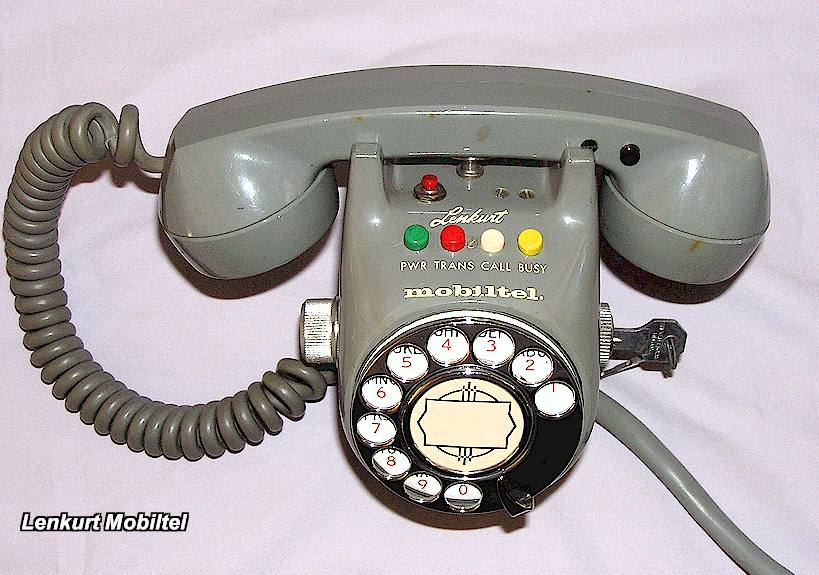
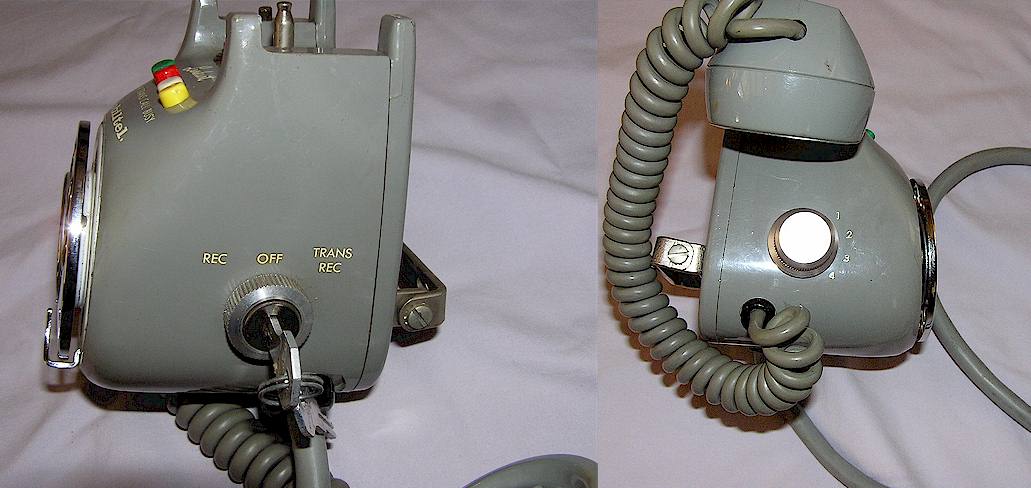
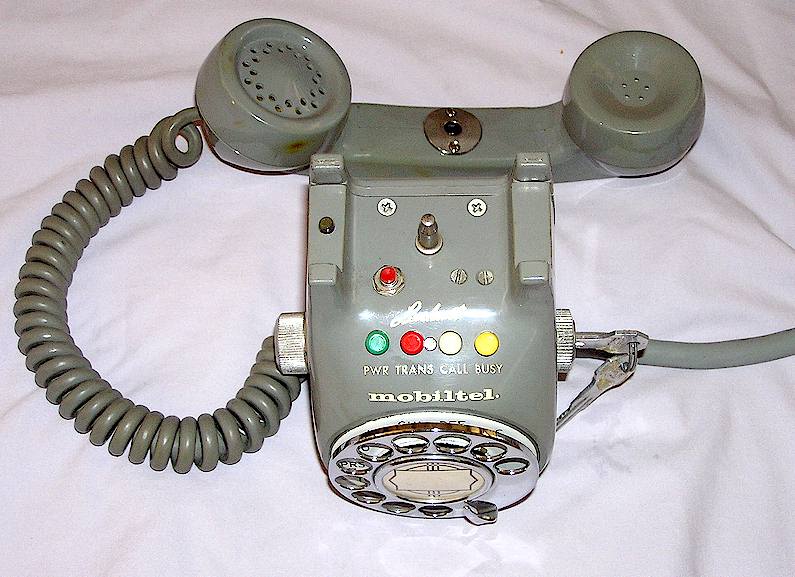
The first generation Lenkurt Mobiltel head shown in the somewhat shabby photo below was on eBay in approximately 2011. Note that it has only three indicator lamps, and they are larger. This version probably had no Busy lamp. Further, the red "Initiate" button appears to be missing. It is possible this was an MTS-only head and the dial had no purpose (included for future options.)
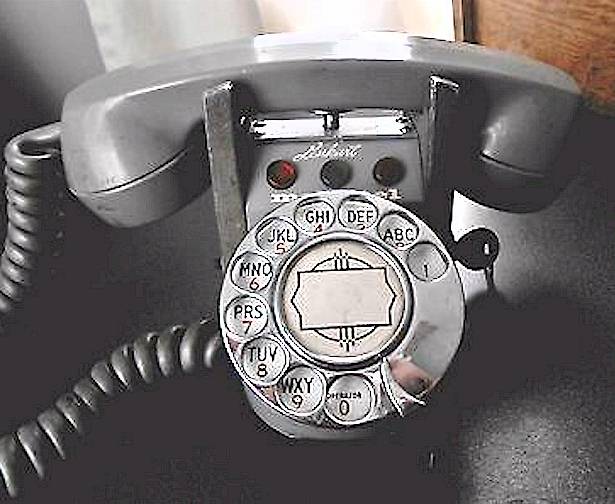
Shown below is a rather romantic magazine ad GTE and Automatic Electric ran to promote Mobiltel. This is a bit odd as the demand for mobile telephone service was great enough in almost all areas that the any of the telephone companies had no need to advertise it. This advertisement was probably intended, more or less, to promote GTE and Lenkurt themselves rather than the phone service they were offering. Note that this painting shows three lamps on the head rather than four and is of the "early" style Mobiltel head shown directly above. The busy light and busy channel lockout may have been options, as they were on the GE Progress and MASTR CC56 "Dial" and "Identified Dial" heads.
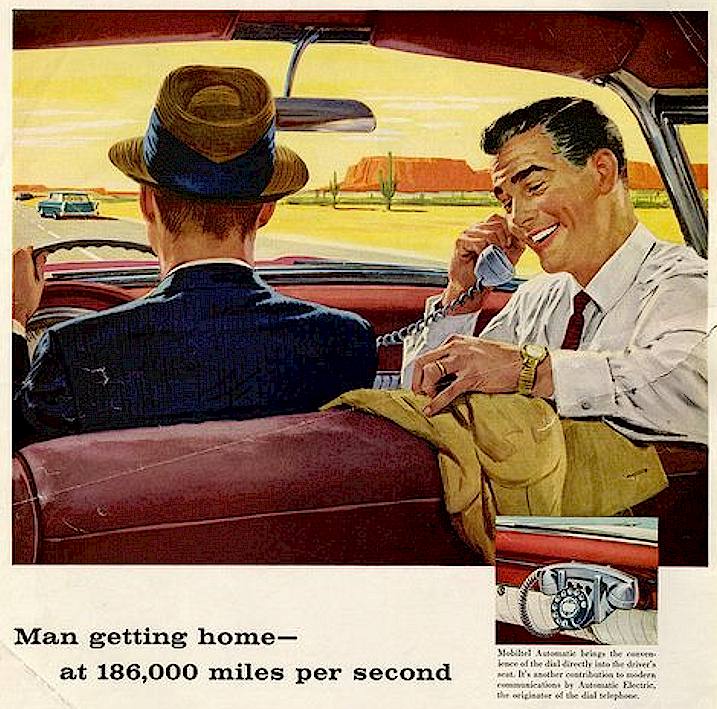
Motorola Pushbutton Radiotelephone, 1960
In approximately the same time that the Automatic Electric-Lenkurt telephones were being made for GTE, i.e. 1960, Motorola was trying to sell their competitive and proprietary "Pushbutton Dial" telephones to the independents. The Bell System never used the Pushbutton Dial equipment, and it is unknown how many independents did. Pushbutton Dial was no longer offered by Motorola once IMTS was being promoted (1964.) Note that Pushbutton Dial is not Touch-Tone® or DTMF. It was a proprietary tone system developed by Motorola, and the tones were a fixed length determined by the circuitry of the head such that once a button was pushed, it would stay depressed until the pre-established tone length had been completed, and it would then pop back up. Pushbutton Dial was fully compatible with MTS signaling in the land to mobile side, only the mobile to land signaling was unique to this format. This allowed a Pushbutton Dial phone to be used as an MTS mobile phone in "foreign" areas.
Pushbutton was an interesting system proprietary to Motorola which first saw limited service in rural co-op exchanges and small independent telephone companies such as REA* co-ops, which could not afford the overhead of a human operator to process and toll ticket calls. It appears to have been manufactured from late 1957-1963 and competed with an Automatic Electric system in 1957-1958 for REA contracts. These control heads were used both mobile or in homes (with a telephone-like handset cradle on the top.)
The Pushbutton Radiotelephone mobiles were not duplex, but push to talk, and consisted of regular Motorola "T-Power" and first generation "Motrac" equipment on one or two VHF high band channels. Later versions of the Pushbutton Radiotelephone head had a cradle arrangement mounted directly across the front for handset mounting, with the key lock in that cradle and a two-channel switch where the key lock is shown in the version below. Earlier versions hung the handset in a separate cradle elsewhere in the car dash area. Interestingly, the pushbuttons stay depressed when dialing until the control head is finished sending that digit. In other words, each digit is sent for a pre-determined period, over which the user has no control. It must have been a bit disconcerting to dial this phone, when the head seemed to have a mind of its own.
The United States Government appears to have also purchased Pushbutton Dial equipment for use in their private exchanges, perhaps on large military bases. The example shown below contains a "U.S. - AEC" property tag.
This phone had an interesting feature in later models, the "break-in" switch, which allowed a user to break into an already busy channel if he had an emergency. This switch was on the rear of the control head, and when activated, sent out a tone to let the conversation on the channel know that someone was breaking in. The black screw-in caps hold aircraft style "grain of wheat" lamp bulbs which illuminate the entire panel.
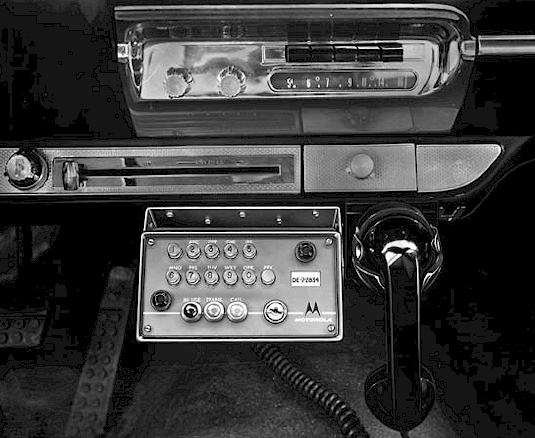
Shown below is a control head used by the Churchill County Tel. and Tel. Co. in Fallon, Nevada in 1960. Note the handset cradle across the front and the 2 frequency selector. It was used with a U63HHT-1100A series first generation Motrac mobile radio. In the 1990 mobile telephone roaming guide by Communications Publishing, Churchill County Telephone is still listed as running a VHF system with 4 channels. The guide simply says "Roamers are diverted to an operator" and that "Manual users press handset button and wait for operator." It thus appears that this company may have been using an IMTS terminal configured to divert roamers or dead carriers on the input channel to the operator. It would be interesting to know more about this system - - if you know, please contact me!
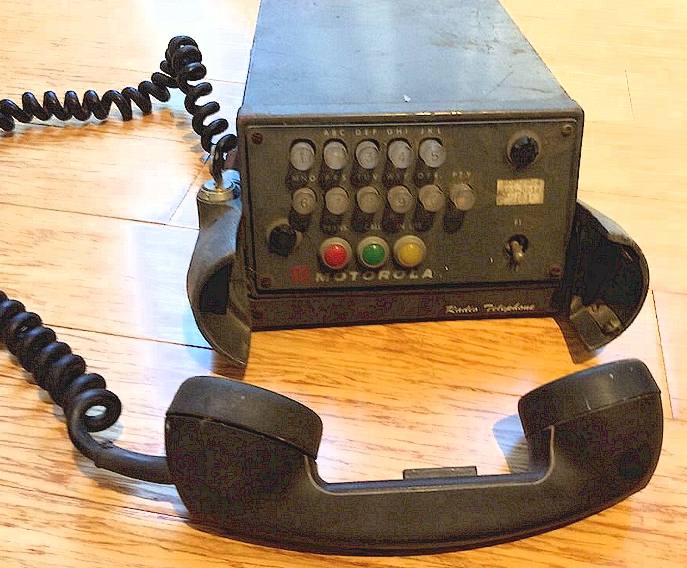
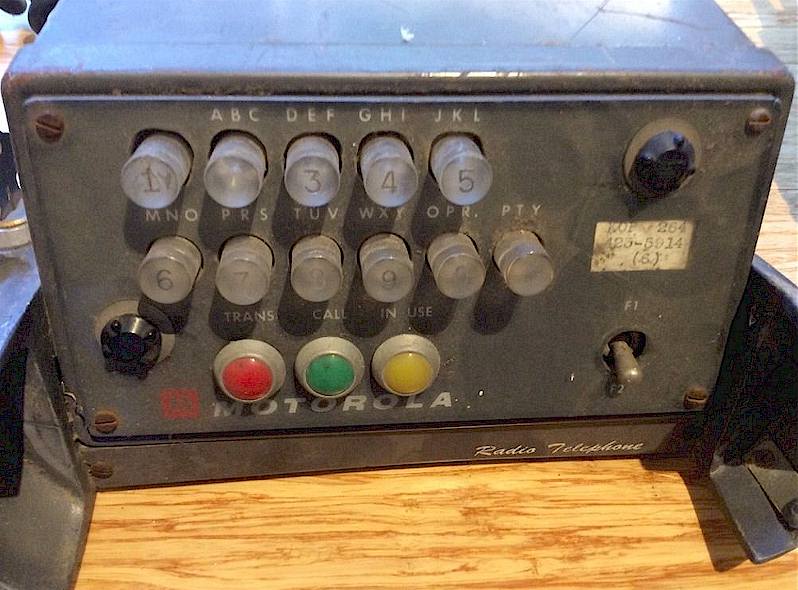
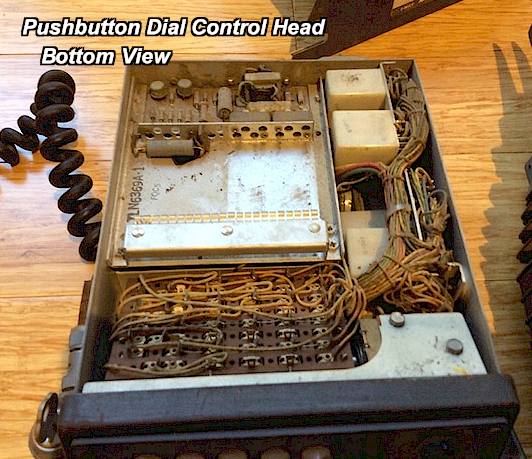
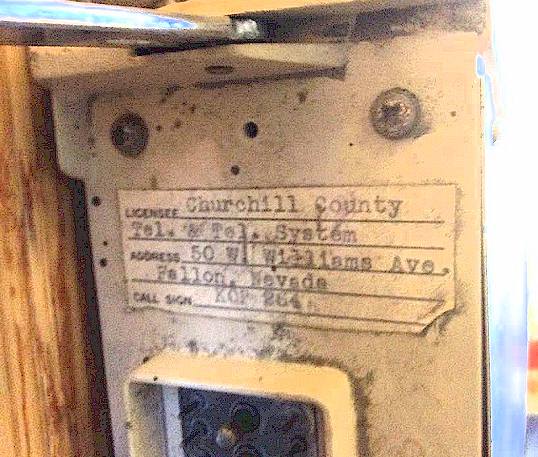
CLICK HERE FOR MOTOROLA BROCHURE PHOTO OF THIS HEAD WITH MOTRAC RADIO
(650 kb .jpg photos)
CLICK HERE FOR ANOTHER BROCHURE PAGE
* REA = Rural Electrification Administration, a government grant and administrative program to bring modern utilities to isolated areas.
SECODE-WABCO IMTS RADIOTELEPHONE, 1964
This equipment is difficult to classify as it possibly belongs in the later IMTS pages as that is what it was designed for, although at least the model below has only 5 channels and thus does not meet the full "MJ" IMTS standard of 11 channels. It was intended for sale to the independent non-Bell telephone companies as AT&T had bypassed Secode in the selection of a radio package for its new IMTS telephone designs.
WABCO stands for Westinghouse Air Brake Company, a division of Union Switch and Signal. The radio division of WABCO seems to have been created in the early 1960's, anecdotally by a group of engineers who came from RCA's mobile radio division. The WABCO radio division primarily if not exclusively made radio equipment for railroads, which was the primary business of WABCO itself. WABCO's radio division seems to have been gone by approximately 1970.
In at least one instance, WABCO briefly produced a mobile telephone as an OEM manufacturer. The WABCO radio package below was a railroad product dating from approximately 1964 supplied to Secode Corp. with added components for mobile telephone use and badged "Secode." Secode was a leading manufacturer of tone signaling equipment prior to IMTS development but for some reason was not picked by AT&T as the contract manufacturer for the signaling system equipment, only for the "MJ" control head.
Secode tried to break into the mobile radio market on its own, intending to sell to the independent telephone companies as a "niche" market, and needed an RF package to go along with their line of tone signaling and control head equipment. The model below does not contain 11 channels, rather 5, as apparently these were supplied in versions less than the full 11 channels. It required an external signaling package as WABCO was not interested in manufacturing everything inside the mobile drawer. A Secode control head was employed. The model below has a duplexer mounted in it so that the telephone would be full duplex. Apparently there were cabling modifications made to the original WABCO radio to allow supervisory operation from an external unit, which required a number of additional wires.
The WABCO equipment is extremely rare today as few were been sold, other than as samples and prototypes, and it is one of the most unusual products. Unfortunately I have no photos of the signaling unit. There was a WABCO mobile telephone offered as a Buy-it-Now on eBay for something around $ 2500 which of course never sold, and the only photo was of a standard IMTS "MJ" style control head.
The Secode IMTS mobile telephone was the drawer unit shown below, with a rather large external signaling and supervisory unit in its own separate box, and a standard Secode "MJ" control head. As mentioned, very few were made, as the independents did not choose them in the end, other than a small number of "trial" units. Secode invested a rather large sum of money into this project, which was essentially lost, although in later patent litigation, AT&T wound up paying Secode for infringing its IMTS patents, among other items deemed Secode's intellectual property.
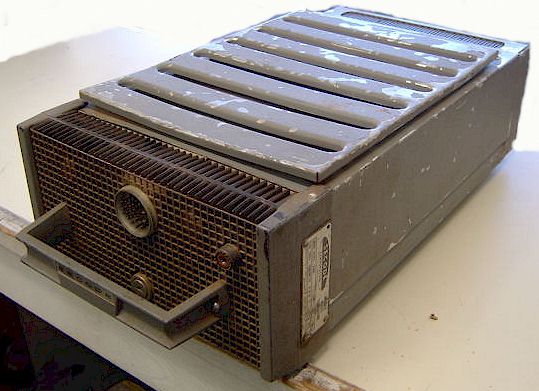
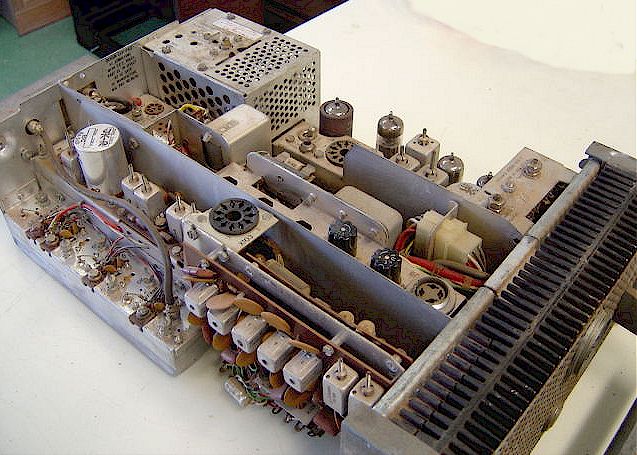
Post-1964:
Once IMTS was introduced in 1964, the independents quit manufacturing their own equipment and simply used "off the shelf" equipment made by Motorola, GE and a few others. They did this even though few offered the actual IMTS service for many years, some waiting until the late 1980's! The independents were the principal users of the "Dial" format sold by GE in 1959 with their Progress Line "Duplex" mobile telephones and some continued to do so with the GE CC56 "MASTR" mobile telephones into the late 1970's.
A typical example of a late "Dial" installation would be the GE MASTR CC56 beige equipment shown above, used the Mojave Desert area of California through the 1970's by Con-Tel.
Information on independent telephone company equipment and systems is very hard to come by. If you can share any information, manuals, equipment and so on, please contact me!
BACK TO MOBILE TELEPHONE HISTORY INDEX
Ver. 10-4-2020 © Geoffrey C. Fors 2014 All rights reserved